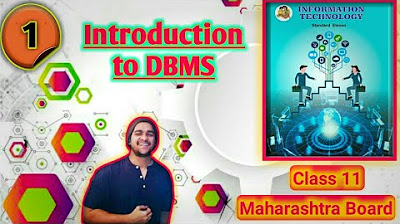Materi Database Kelas XI Hirarki Basis Data
Summary
TLDRThis video tutorial explains the concept of databases, starting with the hierarchy of data storage from the smallest unit of bits to fields, records, files, and eventually databases. It emphasizes the importance of databases in organizing large amounts of data efficiently, making retrieval faster and more accurate. The video also discusses the role of Database Management Systems (DBMS), highlighting their advantages over manual data handling, such as reducing redundancy and improving accuracy. Through examples, it demonstrates how data is structured, stored, and accessed in databases to support better management and sharing of information.
Takeaways
- 😀 A database is a collection of data that is organized and can be accessed, managed, and updated efficiently.
- 😀 Data starts from the smallest unit, a bit, and progresses through stages like byte, field, record, and file, eventually forming a database.
- 😀 A database is like a filing cabinet where data is stored and organized, making it easier to retrieve.
- 😀 A Database Management System (DBMS) is used to store and manage databases, helping to keep data organized and accessible.
- 😀 Using a database system improves data retrieval speed compared to manual storage systems, especially as data grows in volume.
- 😀 One of the key benefits of using a database is accuracy, as it can prevent data inconsistencies and duplication.
- 😀 Databases help in saving storage space by reducing the need for physical records, such as files and maps.
- 😀 Data stored in a database can be shared and accessed by multiple users, unlike physical records that are limited to one location.
- 😀 Redundancy and duplication of data are common problems in manual data handling but can be avoided with a proper database system.
- 😀 In a database, relationships between data are established through keys, which link different data sets together.
- 😀 Key operations in database management are CRUD (Create, Read, Update, Delete), which are essential for handling data within a database system.
Q & A
What is the purpose of a database?
-A database is designed to store and manage large amounts of data efficiently. It makes data easier to search, manage, and retrieve, and helps avoid the issues faced with manual data storage, such as redundancy, inaccuracy, and slow retrieval.
How is data organized in a database?
-Data in a database is organized in a hierarchy starting from bits, which form bytes, then fields, records, files, and ultimately databases. This structure helps in systematic data management and retrieval.
What is a Database Management System (DBMS)?
-A Database Management System (DBMS) is a software system used to manage databases. It helps in organizing, storing, and accessing data efficiently, and enables multiple users to access and manipulate data concurrently.
Why is a database needed instead of manual data storage?
-As the volume of data grows, manually managing it becomes impractical. A database allows for faster searches, ensures data accuracy, reduces redundancy, and provides easier access and sharing of data across different users.
What are some key benefits of using a database?
-Some key benefits include faster data retrieval, improved accuracy, reduced storage space, better data sharing, and prevention of data duplication and redundancy.
What is redundancy in the context of data management?
-Redundancy refers to the unnecessary duplication of data. In manual data storage, the same data might be entered multiple times, leading to inconsistencies. A database helps prevent this issue by centralizing data management.
What is the meaning of 'entity' in a database system?
-An entity represents an object or thing in the real world, such as a person, product, or event. In a database, entities are typically modeled with attributes that describe them.
What are 'attributes' in a database?
-Attributes are characteristics or properties that define an entity. For example, in a 'Customer' entity, the attributes could include name, address, and phone number.
What is the purpose of an Entity-Relationship Diagram (ERD)?
-An Entity-Relationship Diagram (ERD) visually represents the entities, their attributes, and the relationships between them in a database. It helps in designing and understanding the structure of the database.
What are the CRUD operations in a database system?
-CRUD stands for Create, Read, Update, and Delete. These operations allow for the creation, retrieval, modification, and deletion of data in a database. They are fundamental for managing data in any DBMS.
Outlines

此内容仅限付费用户访问。 请升级后访问。
立即升级Mindmap

此内容仅限付费用户访问。 请升级后访问。
立即升级Keywords

此内容仅限付费用户访问。 请升级后访问。
立即升级Highlights

此内容仅限付费用户访问。 请升级后访问。
立即升级Transcripts

此内容仅限付费用户访问。 请升级后访问。
立即升级浏览更多相关视频

KONSEP DASAR SISTEM MANAJEMEN BASIS DATA #1 [PERANCANGAN BASIS DATA]

12 April 2025

Pengertian Data dan Basis Data | Basis Data

Introduction to the concept of Data and Database Management System

BASE DE DATOS DOCUMENTALES, ESTRUCTURA Y PRINCIPIOS DE USO

Chapter 2 Class 11 Maharashtra State Board Information Technology Introduction of DBMS std 11th IT
5.0 / 5 (0 votes)
